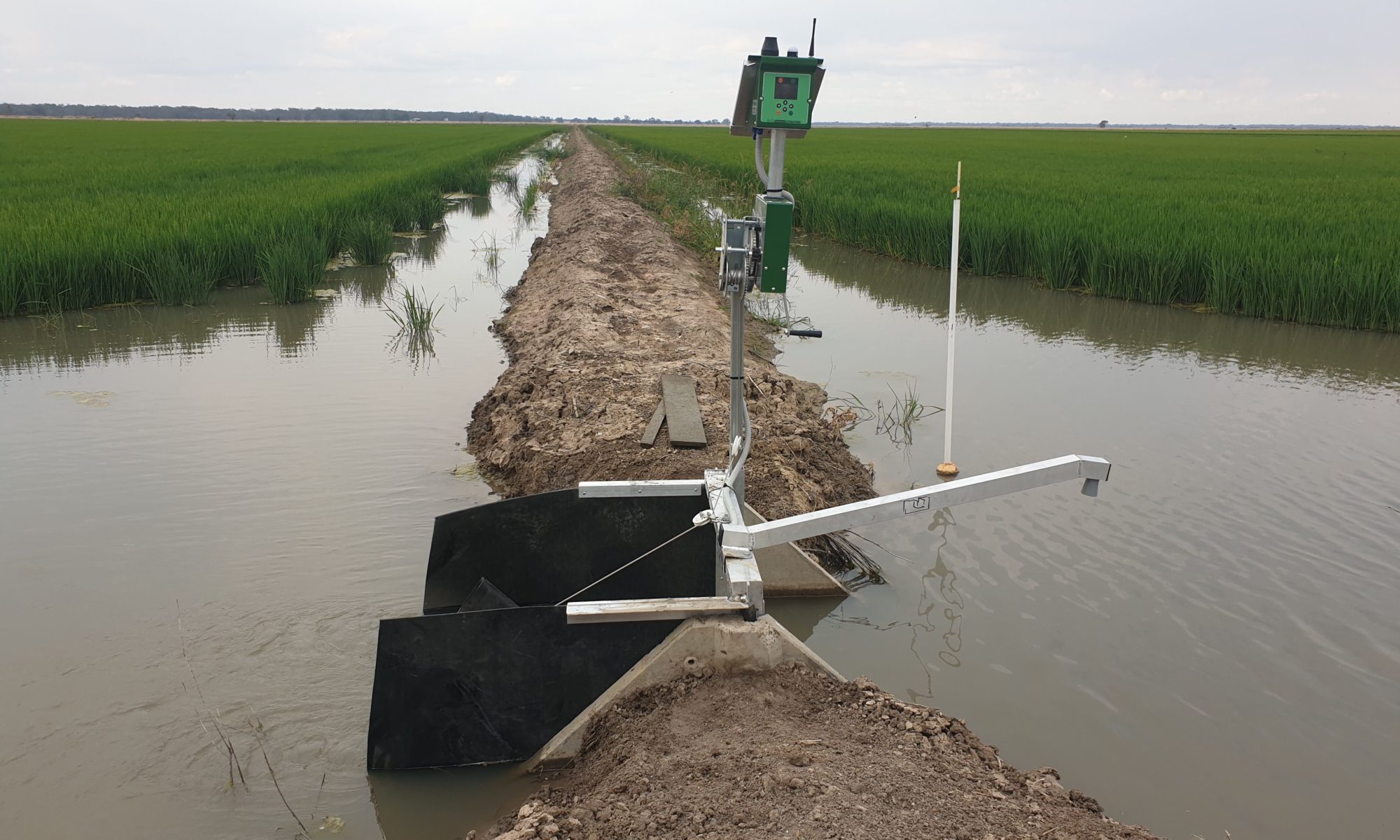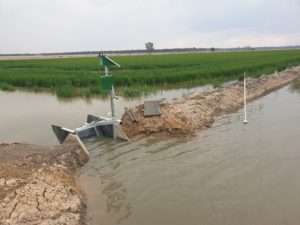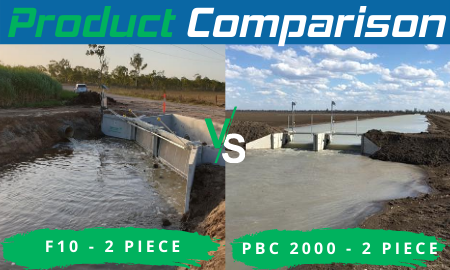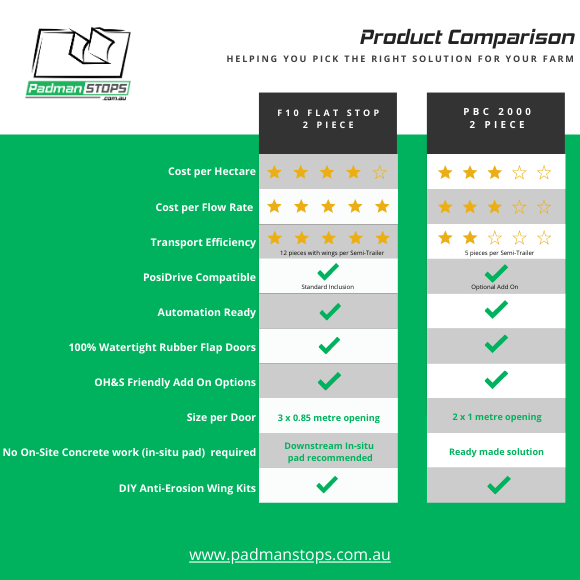Furrows fed by LPTB (Large Pipe Through Bank) or Pontoon Surface Irrigation
Guest post by Mike Naylor – 23 07 2021.
The features of Large Pipe Through Bank systems apply similarly to Border Check or Pontoon systems. The difference is having hills to grow row crops on, which reduces the risk of rain and irrigation induced waterlogging.
Many farmers want to get away from siphons and rotabucks at the head of their row crop fields.
Remember a good siphon system distributes flow reasonably evenly to each furrow if the supply and field top are almost level. Flowrate changes can be accommodated by starting only the number of siphons required for the available flow and head. Flow per furrow can be increased by using larger diameter siphons or using 2 or more per furrow. Labour requirement is intensive.
Large Pipe Through Bank setup.
Assuming watering direction is downslope, near square to the supply channel which is near level (0.00 to 0.02%).
Poor subbing soils.
For poor subbing soil downslope should be 0.03-0.10%. This allows the depth of water in the furrow to be increased by increasing flow and reducing bay width. Furrows should be slightly shallower.
Road and bankless feed.
Access will be on the field side of the supply channel. Usually the material cut from the bankless feed channel and batters provides enough fill for the road. Note batters for bankless feed and road should be 1 vertical on 10 horizontal or flatter.
This allows safe turning for equipment.
The road, bankless feed and flat area should all be parallel to the supply channel.
The bankless feed should slope down to the inlet pipe (or other drain) to allow drainage of bankless feed to the supply. I suggest 0.02% or 0.03%.
The top 25-40m (5 to 8 bucket widths) of the field or each bay must be carefully levelled to zero grade. This section of the field helps even out the flowrate between furrows. As the furrow grade increases then the width of the flat area should increase. Likewise as the number of furrows per bay increases the width of flat area should increase. The flat area height should closely match the field slope at the join, rather than step down.
If the field slope in not square to the supply the flat area must be parallel to the supply. In this case the bankless feed will need to be wide enough to the listing/ bed shaping rig and tractor can sit in the bed width and field side batter may need to be flatter (wider). This is to help overcome the tendency for the rig to dig in one side as the tractor oscillates through the batter and into the bankless then up the road batter.
Bankless feed depth.
The bankless feed needs to start at each edge of each bay at a depth below the furrow depth. Usually furrows are 120-150mm below the landformed surface and the bed or hill 40 -120mm above landforming. You need to measure this with a straight edge over the top of a set of rows and apply to your design.
I usually use 200mm starting depth as this allows for some spoil from the listing / bed shaping process.
Bay width / machinery.
Bay width is to be a multiple of machine runs. Think long and hard about this. Most machinery is either 6, 8 or 12 row. Does your rig pull up 7 full rows and 2 half rows? How does the seeder fit the furrows, as compared to the hills. How does the boom spray fit? How does the harvester fit (especially cotton pickers)? It is good to be able to go up and back i.e. lots of two machinery runs, so number of lister/bed shaper/seeder runs should be divisible by 2.
Bay width / flow rate.
The key to making these systems work well is having enough flow rate per furrow. Most siphon systems used about 80 of 65mm or 100 of 50mm siphons for around 10ML/d, 1 siphon per furrow. This is 0.125 or 0.10ML/d/furrow and were changed every 6, 8, or 12 hours depending on run length and how it suited labour availability.
For Large Pipe Through Bank the minimum is 0.2ML/d/furrow for soils which sub well. It is difficult to get even flow per furrow at this low rate and furrows should not be long.
0.4-0.6ML/d/furrow works well. Increasing the flow per furrow tends to overcome differential flow per furrow out of the feed bankless. If you can, test the maximum capacity of your furrows in a siphon field.
With 15ML/d inflow 30 furrows at 0.5ML/d can be irrigated. This is 5 lots of 12 furrows per bay. Do you have an extra furrow on the outside?
6 lots of 12 furrows gives 4.8 ML/d/furrow. 72m is a multiple of 1.8m beds (not 1.8288) and 1m hills if you want a bet each way between beds and hills and think 2m beds are too wide.
I have reports of recirculation rates of 30% plus for these systems (and siphons). Your starting bay should be the narrowest and the rest can be marginally wider to use added recirculation flow.
The last set should be irrigable with the recirculation flow only to near empty the drain.
See your designer.
Dividing banks.
Each bay has a bank blocking the bankless feed and running onto the flat area to stop water flowing between blocks for fields with no sidefall or steps. For sidefall and steps the bank should extend the length of the field. Think hard again where the bank will be in relation to machinery runs. You don’t want a set of wheels on a machine coming up onto the bank. Either center of the rig or between runs.
Pipe size.
The flow rate per bay and available head determines the pipe diameter. Length is determined by the road width.
Usually the road and bankless feed have a land forming bucket width of 4.3 or 5m.
The pipe needs to be long enough to get from the supply structure to the bankless feed bed or a linking cut be made. Three 2.44 concrete pipes is usually about the right length. Some people only use two pipes. This results in a road for ute access only.
Again, position the culvert to be avoided by machinery runs.
The whole culvert consists of a pipe end pit or headwall, 2 socket/ spigot and 1 spigot/spigot pipes and a bubbler or tail wall.
If the supply channel can be drained then it is possible to drain the bankless feed channel back to and out the supply. I strongly recommend that the bankless feed be drainable, either to the supply, from bay to bay (requires sidefall) or back under the supply to a drain. This expedites access for machinery between irrigations.
This then determines the height of door in the inlet, its sill elevation and the sill elevation of the bubbler or headwall nib. The pipe must fit so drainage can happen. It does not need to flow full.
You can use one culvert to handle all the available flow into a wide bay or divide the width between several smaller outlets. If you follow this to its ultimate end the answer is to go back to siphons!
A fairly standard structure I use is a Padman PE900, 750 diameter pipes and a Padman 900 bubbler. This is good for about 30ML/d and irrigates up to 72 furrows. The equivalent is two Padman PEXL, 450 dia pipes and a smaller bubbler. The head required by the 750 diameter is about 70mm and the 450s require about 150mm. The PEXL can be coupled with larger diameter pipes but the width and depth of flow through the PEXL throat becomes limiting if the flowrate is increased.
The delivered, installed cost is similar. However there is no future in installing this system without considering automation. The automated cost will favor 1 bigger outlet if you always have the flow to be able to use it.
The bigger inlet pit with taller door and lower head requirement make installation to drain back less demanding than for the PEXL. The bigger bubbler has a wider sill and higher headwall to stop erosion.
The rubber flap system is usually waterproof so leakage into a dry field is unlikely (not usually so with slide doors).
The tail end – Large Pipe Through Bank
The drainage end of the furrows at least needs a standard row crop tail drain and main drain system.
To minimise drainage, recycling and improve irrigation efficiency each bay or irrigation set should have a flatter slope at the bottom of the run and an automated outlet to the recirculation drain.
This allows drainage from fast rows to be backed up the slower rows to even up irrigation. This applies to siphons too but the number of structures is reduced because of lower flow per furrow and more furrows per set.
Have you considered a system like GL (Glenn Lyons), Furrows in Level Terraces, or indeed a pressurised piped system for your site?
Happy irrigating and thanks for my next meal.
Mike.
Note: This information on Large Pipe Through the Bank is of a general nature, you must consult your irrigation designer to confirm your choices. Irrigation structures should be part of your design.

About Mike Naylor
Mike Naylor is an irrigation designer at Mike Naylor Irrigation in Leeton, NSW. He has been a true friend of the Padman Group for more years than we can remember.
Contact Mike on:
Phone: 0427532259
Email: mikednay@gmail.com








